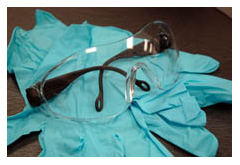Archival Notice
This is an archive page that is no longer being updated. It may contain outdated information and links may no longer function as originally intended.
Home | Glossary | Resources | Help | Contact Us | Course Map
OSHA standard 29 CFR 1910.132 provides a general discussion of the requirements for personal protective equipment and its use.18
The standard discusses:
- Hazard assessment and equipment selection (selecting the appropriate personal protective equipment, or PPE, for the task) - 29 CFR 1910.132(d)
- Training - 29 CFR 1910.132(f)
- The employer is required to train the employees
- The employer must verify that the employee understands the training principles, documented by a dated certificate.
- The training shall encompass:
- When PPE is necessary
- What PPE is necessary
- Limitations of PPE
- Proper care, maintenance, and disposal of PPE
OSHA standard 29 CFR 1910.120 Appendix B (non-mandatory) is a general description and discussion of the levels of protections and protective gear.19
This standard defines the levels and when they should be used:
|
Levels of OSHA 29 CFR 1910.120 Appendix B |
|
|
Level |
Type of Protection Recommended |
|
Level A |
Greatest level of skin, respiratory, and eye protection required |
|
Level B |
Highest level of respiratory protection is necessary, but a lesser level of skin protection is needed |
|
Level C |
The concentration and type of airborne substance is known and the criteria for use of respirators are met |
|
Level D |
Work uniform providing minimal protection, used for nuisance contamination only |
OSHA Standard 29 CFR 1910 Subpart I Appendix B Non-Mandatory Compliance Guidelines for Hazard Assessment and Personal Protective Equipment Selection provides compliance assistance for employers and employees in implementing requirements for a hazard assessment and the selection of PPE.20 The assessment takes into consideration the tasks performed, the location of the tasks, and chemical sources of hazards.
Some laboratories utilize a Personal Protective Equipment Use Assessment (or similarly titled document) to define which PPE is to be used for each laboratory task or procedure. (i.e., performing analytical chemistry using acids, washing glassware, test firing a weapon, etc.)
OSHA Standard 29 CFR 1910.133 Eye and Face Protection discusses the general requirements for eye and face protection.21
Additional Online Courses
- What Every First Responding Officer Should Know About DNA Evidence
- Collecting DNA Evidence at Property Crime Scenes
- DNA – A Prosecutor’s Practice Notebook
- Crime Scene and DNA Basics
- Laboratory Safety Programs
- DNA Amplification
- Population Genetics and Statistics
- Non-STR DNA Markers: SNPs, Y-STRs, LCN and mtDNA
- Firearms Examiner Training
- Forensic DNA Education for Law Enforcement Decisionmakers
- What Every Investigator and Evidence Technician Should Know About DNA Evidence
- Principles of Forensic DNA for Officers of the Court
- Law 101: Legal Guide for the Forensic Expert
- Laboratory Orientation and Testing of Body Fluids and Tissues
- DNA Extraction and Quantitation
- STR Data Analysis and Interpretation
- Communication Skills, Report Writing, and Courtroom Testimony
- Español for Law Enforcement
- Amplified DNA Product Separation for Forensic Analysts


